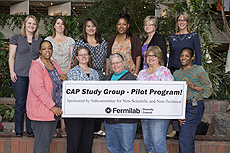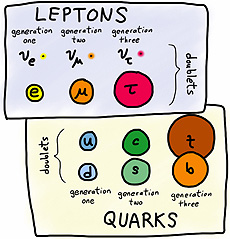|
Have a safe day!
Friday, Oct. 5
3:30 p.m.
DIRECTOR'S COFFEE BREAK - 2nd Flr X-Over
4 p.m.
Joint Experimental-Theoretical Physics Seminar - One West
Speaker: Rustem Ospanov, University of Pennsylvania
Title: Recent Higgs Results from ATLAS
Monday, Oct. 8
THERE WILL BE NO PARTICLE ASTROPHYSICS SEMINAR THIS WEEK
3:30 p.m.
DIRECTOR'S COFFEE BREAK - 2nd Flr X-Over
THERE WILL BE NO ALL EXPERIMENTERS' MEETING THIS WEEK
Click here for NALCAL,
a weekly calendar with links to additional information.
Upcoming conferences |
|
Friday, Oct. 5
- Breakfast: blueberry-stuffed French toast
- Hungarian pork goulash soup
- Chicken fajita sandwich
- Polish reuben casserole
- Smart cuisine: catch-of-the-day seafood linguine
- Eggplant parmesan panini
- Green and white pizza
- Breakfast-for-lunch omelet bar
Wilson Hall Cafe Menu
|
|
Friday, Oct. 5
Dinner
- Vol-au-vents with mushroom duxuelle
- Grilled duck breast with lingonberry sauce
- Wild rice
- Brussels sprouts with bacon and lemon
- Profiteroles with brandied pears and chocolate sauce
Wednesday, Oct. 10
Lunch
- Baked cornish hens with mustard sauce
- Broccoli and rice
- Pumpkin pie with spiced cream
Chez Leon Menu
Call x3524 to make your reservation.
|
|
How spam filtering works at Fermilab
 |
As with your postal mail, it's challenging to eliminate all the junk in your e-mail. The people behind FermiMail have been modernizing the laboratory's e-mail spam detection system to keep junk mail to a minimum. |
Did you know that by some estimates, as many as nine out of 10 e-mail messages are spam? As part of the FermiMail implementation project, the e-mail team modernized the e-mail system's approach to detecting spam. But, as with your postal junk mail, achieving an error-free filter to catch all spam is not possible, partly because one person's junk mail is another's valuable correspondence.
The current Fermilab spam filtering process relies on spam signatures – a collection of known attributes of previous spam e-mail messages – that are provided with near real-time signature updates. The process uses a weighing system that evaluates several characteristics of each e-mail to rank the likelihood that it is spam. Messages of a high enough weight are considered to almost certainly be spam and are discarded by the e-mail system. Messages of a sufficiently low weight are considered to almost certainly be legitimate and are delivered to your inbox. Messages in the middle range are considered suspect and are tagged according to their weights, but are still delivered to your inbox. All messages in your inbox have a weight assigned known as a spam confidence level, or SCL, which allows your email client (or mailbox filter rules) to take certain actions, such as filing the message in the junk mail folder, based on this weight.
This is how the e-mail filtering process is done on the e-mail servers. Each e-mail client, however, may have its own evaluation method for spam. For instance, Outlook clients have a built-in spam filter that looks not only at each individual message, but also at patterns, frequency of and similarities in groups of messages. This is why you may see changes in the way your client handles legitimate messages over time, causing messages not previously classified as spam to start being marked as such.
E-mail clients often have options for you to mark messages with certain characteristics as legitimate, a process known as "whitelisting." For example, you might choose to indicate that all messages from a certain sender should be considered legitimate. These features help you control what is classified as spam in your mailbox with your specific e-mail client.
No spam filtering system is perfect – some spam will always get through. But the tools on the e-mail servers and in your e-mail client should prevent the vast majority from flooding your inbox.
Learn more
—Tom Ackenhausen
|
Pilot study group to complete Certified Administrative Professional course
 |
Front row: Kappatolia Sherman, Karen Seifrid, Marie Herman, Rosa Foote, Carolyn Johnson.
Back row: Anna Campbell, Gayle Millman, Luz Jaquez, Etta Johnson, Anita Menz-Cwiklik, Karen Karlix-Smith.
Not pictured: Linda Diepholz, Lucina Ontiveros and Jamie Grado. Photo: Reidar Hahn
|
In April, a group of administrative professionals from across the laboratory began an employee-led, 20-week course titled Power Boosting Skills for Administrative Professionals. The cohort is scheduled to complete the certification exam on Nov. 3, earning 15 college-level credits with a passing score. A few of the topics covered in the course include business ethics and customer service, written communication, and technology and time management. Visit the course training Web page to learn more about the course, which will be offered again beginning in January 2013.
|
Paul Davies discusses extraterrestrial life next week
Whether or not we are alone in the universe is one of the oldest questions of philosophy. About 50 years ago it became part of science when astronomers began sweeping the skies with radio telescopes in the hope of picking up a message from an extraterrestrial civilization. After half a century of nothing but an eerie silence, what can we conclude? Many scientists assume that life will pop up easily on earth-like planets, but this is merely a belief. How can we test it? One way is to seek out a second sample of life right here on Earth - a sort of shadow biosphere.
On Friday, Oct. 12, Paul Davies, well-known theoretical physicist, cosmologist, astrobiologist and best-selling author, will give a lecture titled "The Eerie Silence: ET, Where Are You?" During the talk, he will cover recent attempts to track down "shadow" microbes and present some bold new ideas for detecting the subtle footprints of advanced alien technology.
Davies' research interests are focused on the "big questions" of existence. His 28 books have been translated into more than 20 languages and are notable for presenting complex ideas in accessible terms.
The lecture takes place at 8 p.m. in Ramsey Auditorium. Tickets are $7. For more information, call 630-840-ARTS or visit the Fermilab Lecture Series website.
|
Quantum measurements leave Schrödinger's cat alive
From New Scientist, Oct. 3, 2012
Schrödinger's cat, the enduring icon of quantum mechanics, has been defied. By making constant but weak measurements of a quantum system, physicists have managed to probe a delicate quantum state without destroying it – the equivalent of taking a peek at Schrodinger's metaphorical cat without killing it. The result should make it easier to handle systems such as quantum computers that exploit the exotic properties of the quantum world.
Read more
|
|
The platypus particle
 |
| A leptoquark would be a strange amalgam of familiar leptons and quarks, the way that a platypus has features of both mammals and birds. Image from Charles Baker, Animals, Their Nature and Uses (1877) |
All of the atoms in our bodies are made of electrons, protons and neutrons, and the protons and neutrons can be further decomposed into quarks. At the bottom level, then, we are made of only two types of particles: electrons and quarks. But what do these labels mean? Why do we even say that electrons and quarks are different from each other?
Since they don't come with nametags, we have to define particles by how they interact. It is a bit like cataloging wildlife on a new continent — at first, everything is strange, but eventually we see how the species can be grouped into patterns. Some animals quack and waddle, so we call them all ducks, while others are furry and build dams, and we choose to call them beavers. When physicists first explored the subatomic world, they noticed that there are two basic types of nuclear interactions, one much stronger than the other. To this day, they are called the weak force and the strong force because they never got better names.
Particles of matter were similarly grouped into two classes, leptons and hadrons, which come from Greek words for small and big. Curiously, leptons seem to be completely unaffected by the strong force while hadrons are utterly dominated by it. Although leptons, such as the familiar electron, can turn into other leptons – muons, taus and neutrinos – the total number of leptons in the universe appears to be constant (counting a matter lepton as plus one and an antimatter lepton as minus one). The same is independently true of quarks, the fundamental building block of hadrons. There may be a deep reason for this similarity, but it isn't yet known.
The resemblance between leptons and quarks is even more striking when we arrange them by the ways they interact with the weak force (see bottom figure). Many physicists suspect that the similarity between leptons and hadrons is not an accident, and that they might be connected somehow. If so, then there could be a new particle that is a little of both — a "leptoquark." Such a thing would be as shocking as the discovery of the platypus, a mammal that lays eggs like a duck yet is furry like a beaver.
As the missing link between leptons and quarks, leptoquarks might explain how more matter emerged from the big bang than antimatter. They might also determine our fate, since they would satisfy the accounting that currently keeps electrons and quarks in atoms from annihilating with each other. If there were a bridge between leptons and quarks, then even ordinary matter could spontaneously decay into pure energy. It would only take a billion-trillion-trillion years.
—Jim Pivarski
 |
| Leptons and quarks naturally fit into three generations of doublets based on the way they interact with the weak force. Physicists do not know why both types of particles conform to the same pattern. |
|
Intensity Frontier brochure available for pick-up
"Particle Physics at the Intensity Frontier," a brochure that explains the Intensity Frontier and the rich particle physics research that awaits us there, is now available for pick-up in the Wilson Hall atrium. It is also available online.
The brochure is a lay-language accompaniment to the final scientific report detailing last year's Intensity Frontier Workshop results, which is also online.
|
|